Executive Summary
Real GDP accelerated in the Eurozone in Q2, as the year-ago pace of economic growth crossed the 2 percent threshold for the first time since Q1-2011. Economic growth has become increasingly broad based in recent quarters amid steady employment gains and improving business sentiment. Looking forward, we expect that the increasingly self-sustaining economic expansion will remain intact. Our current forecast looks for real GDP in the Eurozone to grow 2.1 percent in 2017 which, if realized, would be the strongest annual average growth rate since 2007.
Like several other advanced nations, Eurozone monetary policymakers face a challenging conundrum; the unemployment rate has reached an eight-year low, but core inflation has been listless around 1 percent for the past two years. As such, policymakers at the European Central Bank (ECB) will likely proceed with caution in coming months as they seek to move away from the highly unconventional monetary policy they adopted in recent years while still keeping the economic momentum going. We look for the ECB to maintain its policy rates for the time being and announce a reduction in its monthly bond purchases at the September 7 meeting, although we acknowledge that policymakers could conceivably wait until the October 26 meeting to make the announcement.
Sustainable Expansion Underway in the Eurozone
Data released today showed that real GDP in the Eurozone grew 0.6 percent (2.3 percent annualized) on a sequential basis in Q2-2017 (Figure 1). On a year-over-year basis, real GDP grew 2.1 percent. The outturn marks the 17th consecutive quarter in which real GDP has risen on a sequential basis. Real GDP in the overall euro area is up 7.0 percent since the mild 2011-13 recession ended, and it currently stands 3.7 percent above it previous peak set in Q1-2008.
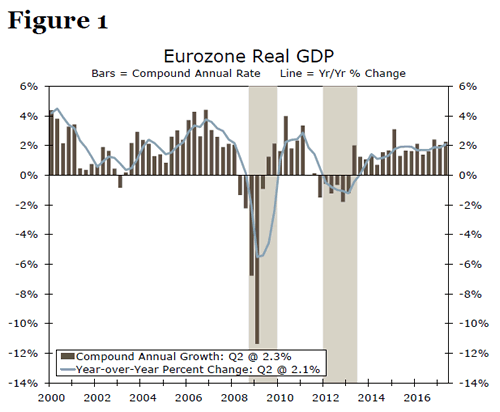
A detailed breakdown of the Q2 GDP data into its underlying demand components is not yet available, but growth in recent quarters has been broad based, which makes the ongoing economic expansion more sustainable. For example, the 1.9 percent year-over-year GDP growth rate that was registered in the first quarter was supported by a 1.6 percent rise in real personal consumption expenditures and by a 3.5 percent increase in real investment spending. Looking at available monthly data from the second quarter, real retail sales were up 0.7 percent (not annualized) in the first two months of Q2-2017 relative to Q1. This growth in real retail spending in conjunction with the uptrend in car registrations (Figure 2) indicates that growth in real personal consumption expenditures remained solid in Q2-2017. Production of capital goods in the first two months of Q2 rose 1.0 percent relative to Q1, suggesting that investment spending likely was solid as well.
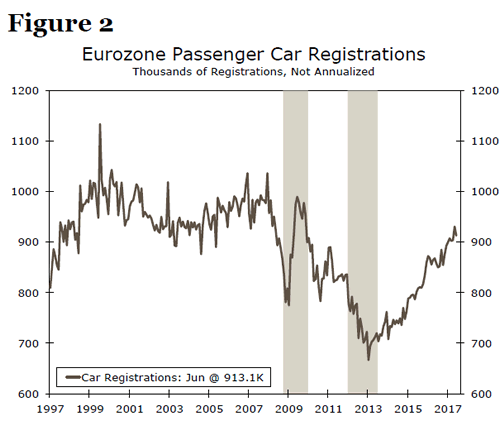
The economic expansion that has been underway in the euro area since 2013 has led to firmer conditions in the labor market. In early 2013, the unemployment rate in the Eurozone exceeded 12 percent (Figure 3). Today, the rate stands at an eight-year low of 9.1 percent. However, despite the solid rate of real GDP growth and the tightening in labor market conditions, inflation remains benign. Although the overall rate of CPI inflation has risen this year, the core rate of inflation, which excludes food and energy prices and which is more reflective of underlying inflationary pressures than the overall rate, has been more or less trendless around 1 percent for the past two years (Figure 4).
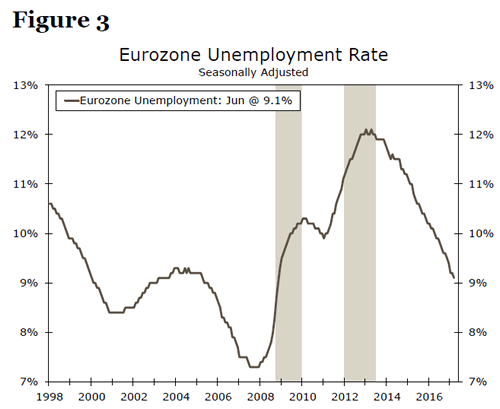
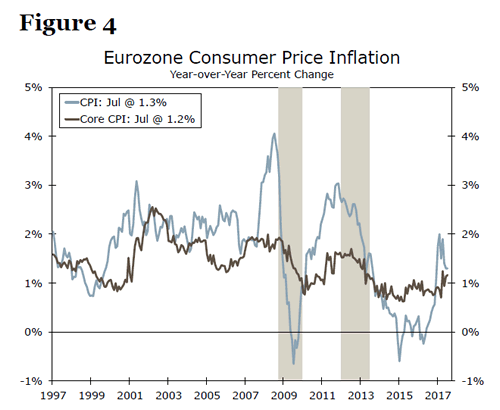
As summarized above, real GDP growth has been broadly balanced across spending categories recently, and it appears that the expansion is becoming increasingly self-sustaining. Looking forward, we expect that the economic expansion will remain intact. Strong growth in employment, which is up 1.5 percent on a year-ago basis, should translate into solid growth in consumer spending, and high levels of business confidence in conjunction with accommodative financial conditions should bolster investment spending. Continued economic growth in the rest of the world should help to support export growth in the euro area. Our current forecast looks for real GDP in the Eurozone to grow 2.1 percent in 2017 which, if realized, would be the strongest annual average growth rate since 2007. We look for 2 percent real GDP growth in 2018.
Policy "Normalization" to Get Underway at the ECB
The European Central Bank (ECB) has the single mandate of "price stability," which it interprets as an overall CPI inflation rate of "below, but close to, 2 percent." In that regard, CPI inflation has been below target for more than four years. Consequently, the ECB Governing Council has turned to "unconventional" monetary policy measures in an attempt to boost inflation back towards its target. Not only has the ECB cut its deposit rate into negative territory (Figure 5), but it has also been engaging in a quantitative easing (QE) program over the past two years.1 Between March 2015 and March 2016, the ECB bought €60 billion worth of government bonds per month, but it ramped up its monthly purchase rate to €80 billion in April 2016. It subsequently dialed back its monthly purchases to €60 billion in April 2017. The ECB QE program has swelled the size of its balance sheet from about €2 trillion in early 2015 to more than €4 trillion today (Figure 6).
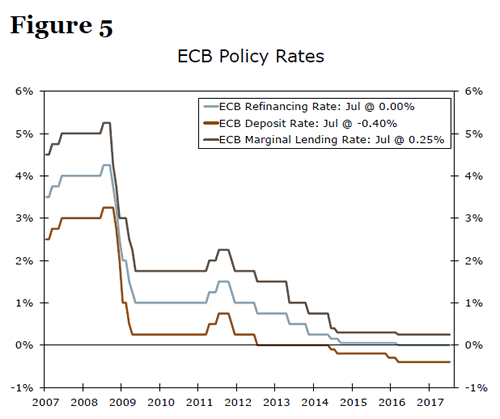
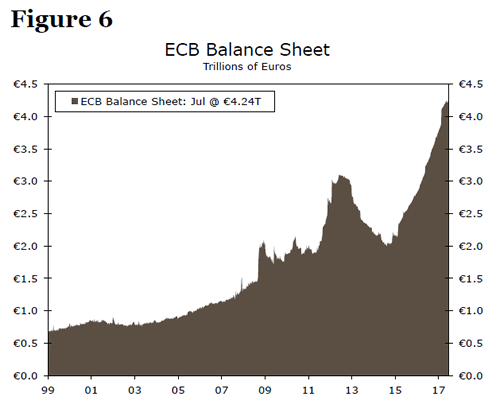
ECB policymakers envision that the €60 billion/month pace will last "until the end of December 2017, or beyond, if necessary, and in any case until the Governing Council sees a sustained adjustment in the path of inflation consistent with its inflation aim." Given the improvement in economic fundamentals, which should eventually lead to higher inflation, we look for the ECB to announce another reduction in its monthly bond purchases. In our view, this announcement will be made at the September 7 policy meeting, although we acknowledge that the Governing Council could conceivably wait until the October 26 meeting to make the announcement. We believe that the next stepdown in the monthly pace of purchases will take effect in December, and we look for the ECB to cease buying bonds altogether by the end of Q2-2018, at the latest.
The Federal Reserve ended its QE program (October 2014) before it hiked rates (December 2015). Likewise, we believe that the ECB will not hike rates until it has completely wound down its QE program. And just like the Fed, we anticipate that the ECB will wait a number of months until hiking policy rates. In our view, it is likely that the Governing Council will first hike its deposit rate while leaving its two-week refinancing rate and the rate on its marginal lending facility unchanged (see Figure 5). Hiking the deposit rate, which currently stands at -0.40 percent and which sets the lower bound for the overnight interbank rate, will push short-term interbank rates up from negative territory back toward zero percent. Taking the deposit rate into negative territory was an "extraordinary" policy measure, and it seems that the Governing Council would want to first phase out its "extraordinary" measures as it begins the process of "normalizing" monetary policy.
Assuming there are no disruptions in financial markets from the initial hike in the deposit rate, we think the Governing Council will, after a few months, then hike its two-week refinancing rate and the rate on its marginal lending facility. We currently look for the initial hike in the deposit rate in late summer/early fall 2018, with subsequent increases in the refinancing and marginal lending facility rates in Q4-2018. That said, the timing of these rate hikes is highly uncertain and obviously depends on the incoming data flow in coming months. Stay tuned.
Conclusion
Real GDP in the Eurozone rose 0.6 percent in Q2-2017, the 17th consecutive quarter in which economic output in the euro area has grown. The demand-side drivers of real GDP growth appear to be broad based at present, and the economic expansion is becoming increasingly self-sustaining. Although the unemployment rate has receded to an 8-year low, there are few signs yet of a sustained upturn in CPI inflation in the euro area. As a result, we expect the ECB will proceed with caution when shifting from an easing to a tightening policy framework, just like its Federal Reserve counterpart did a few years ago. We look for the ECB to leave its policy rates unchanged for the time being and announce a reduction in its monthly bond purchases at the September 7 meeting, although we acknowledge that policymakers could conceivably wait until the October 26 meeting to make the announcement.












